A) the inheritance of acquired characteristics
B) sexual selection
C) possession of analogous (convergent) traits
D) possession of shared primitive characters
Correct Answer

verified
Correct Answer
verified
Multiple Choice
 Which of the following statements most accurately describes the evolution of chloroplasts?
Which of the following statements most accurately describes the evolution of chloroplasts?
A) Chloroplasts evolved independently in all three domains
B) Chloroplasts evolved in the Archaea
C) Chloroplasts evolved in Eukarya
D) Chloroplasts evolved from a common ancestor of Proteobacteria
Correct Answer

verified
Correct Answer
verified
Multiple Choice
The following phylogeny shows six living species (a-f) and five ancestral (now extinct) species (1-5) . If the phylogeny had been developed on the basis of similarities in bone structure, which of the following predictions would you make in terms of the structure of a particular enzyme? 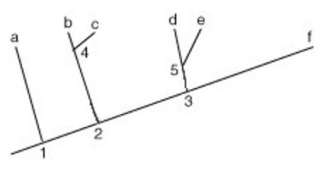
A) The enzymes of species b and f are very similar.
B) The enzymes of species b and c are more similar to ancestor 4 than to ancestor 2
C) The enzymes of species a and b are the same as that of ancestor 2.
D) The enzyme of species c is very similar to that of species d.
Correct Answer

verified
Correct Answer
verified
Multiple Choice
Eukaryotes that are not closely related and that do not share many anatomical similarities can still be placed together on the same phylogenetic tree. Which of the following approaches would be most appropriate for doing this?
A) by comparing their plasmids
B) by comparing their mitochondrial genomes
C) by comparing their homologous genes that are poorly conserved
D) by comparing their homologous genes that are highly conserved
Correct Answer

verified
Correct Answer
verified
Multiple Choice
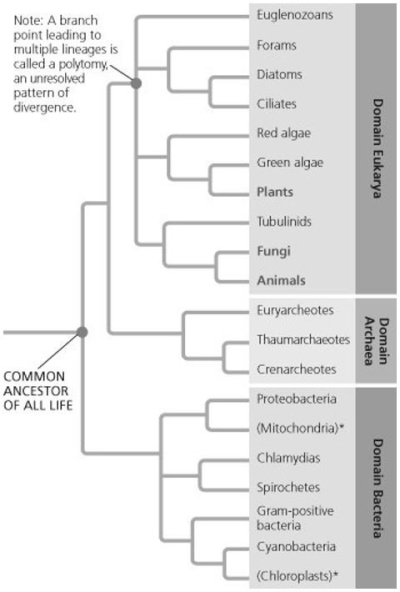 From which taxon did mitochondria evolve?
From which taxon did mitochondria evolve?
A) Bacteria
B) Archaea
C) Eukarya
D) Algae
Correct Answer

verified
Correct Answer
verified
Multiple Choice
In which type of classification system are names assigned only to groups that include a common ancestor and all of its descendants?
A) a system that groups organisms based solely on similar morphologies
B) a system that groups organisms based on similar roles in the environment
C) a system based entirely on evolutionary history
D) a system based solely on cellular structures
Correct Answer

verified
Correct Answer
verified
Multiple Choice
Scientists have hypothesized that the common ancestors of birds and mammals, possessed three-chambered hearts (two atria, one ventricle) . Birds and mammals, however, are alike in having four-chambered hearts (two atria, two ventricles) . Which of the following statements best describes the four-chambered hearts of birds and mammals?
A) they are morphological homologies
B) they exhibit molecular homology
C) they are morphological analogies
D) they are the result of shared ancestry
Correct Answer

verified
Correct Answer
verified
Multiple Choice
Use the following information to answer the question. 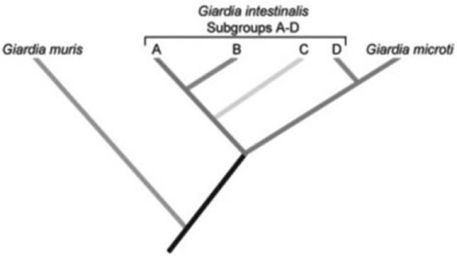 According to the phylogenetic tree in the figure above, what type of evolutionary group does G. intestinalis constitute?
According to the phylogenetic tree in the figure above, what type of evolutionary group does G. intestinalis constitute?
A) analogous
B) monophyletic
C) polyphyletic
D) paraphyletic
Correct Answer

verified
Correct Answer
verified
Multiple Choice
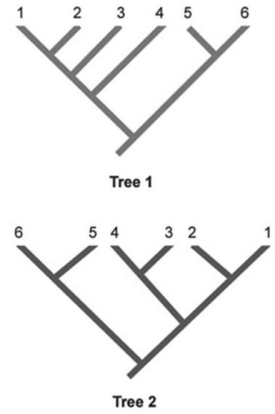 In the phylogenetic trees shown, each number represents a unique species of organisms. Which two species are represented as sister species in Tree 2 but are not represented as sister species in Tree 1?
In the phylogenetic trees shown, each number represents a unique species of organisms. Which two species are represented as sister species in Tree 2 but are not represented as sister species in Tree 1?
A) 1 and 2
B) 2 and 3
C) 3 and 4
D) 4 and 5
Correct Answer

verified
Correct Answer
verified
Multiple Choice
Use the figure to answer the following question. Gymnosperms and angiosperms are both types of plants that produce seeds. 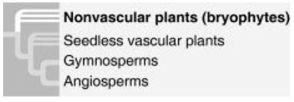 Which of the following claims is best supported by this phylogenetic tree?
Which of the following claims is best supported by this phylogenetic tree?
A) the tree depicts uncertainty about whether the bryophytes or the vascular plants evolved first
B) the tree depicts an evolutionary hypothesis
C) the tree includes evolution of convergent characteristics
D) the tree indicates that seeds are a shared ancestral character of all vascular plants
Correct Answer

verified
Correct Answer
verified
Multiple Choice
The kingdom Monera was dismantled because of which of the following reasons?
A) Some Monera contained nuclei in their cells.
B) The Monera, as originally constituted, contained both plants and animals.
C) The Monera, as originally constituted, was monophyletic.
D) Monera contained organisms from other domains
Correct Answer

verified
Correct Answer
verified
Multiple Choice
What kind of evidence has recently made it necessary to assign the prokaryotes to either of two different domains, rather than assigning all prokaryotes to the same kingdom?
A) mtDNA
B) rRNA genes
C) morphological
D) ecological
Correct Answer

verified
Correct Answer
verified
Multiple Choice
In which phylogenetic tree are the chytrids and ascomycetes shown as being more distantly related than in the other phylogenetic trees?
A) I![]()
B) II (switch chytrids and mucoromycetes)
C) III (switch zoopagomycetes and chytrids)
D) IV (switch chytrids and basidiomycetes)
Correct Answer

verified
Correct Answer
verified
Multiple Choice
Which of the following statements is most consistent with the model of evolutionary relatedness represented in the phylogenetic tree? 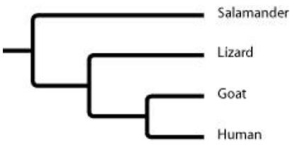
A) Goats and humans are the only sister group in this tree.
B) Salamanders are a sister group to the group containing lizards, goats, and humans.
C) Salamanders are more closely related to lizards than they are to humans.
D) Goats are more closely related to salamanders than they are to humans.
Correct Answer

verified
Correct Answer
verified
Multiple Choice
The question refers to the table, which compares the percent sequence homology of four different parts of a gene (two introns and two exons) that is found in five different eukaryotic species. The data show the percentage of sequence homology of each intron and exon in comparison to the sequences in species A.
Percentage of Sequence Homology
 Which of these four gene parts should allow the construction of the most accurate phylogenetic tree, assuming that this is the only part of the gene that has acted as a reliable molecular clock?
Which of these four gene parts should allow the construction of the most accurate phylogenetic tree, assuming that this is the only part of the gene that has acted as a reliable molecular clock?
A) Intron I
B) Exon I
C) Intron VI
D) Exon V
Correct Answer

verified
Correct Answer
verified
Multiple Choice
The figure represents a phylogenetic tree of birds and their closest relatives. Which group of organisms represents the outgroup in the clade that includes only crocodilians, ornithischian dinosaurs, saurischian dinosaurs, and birds? 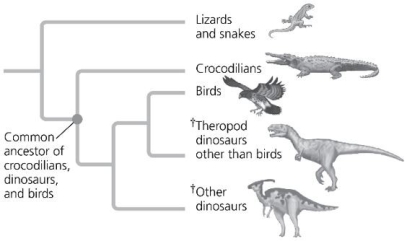
A) lizards and snakes
B) crocodilians
C) ornithischian dinosaurs
D) birds
Correct Answer

verified
Correct Answer
verified
Multiple Choice
The question refers to the table, which compares the percent sequence homology of four different parts of a gene (two introns and two exons) that is found in five different eukaryotic species. The data show the percentage of sequence homology of each intron and exon in comparison to the sequences in species A.
% Sequence Homology
 Based on the data in the table, which phylogenetic tree is the most likely depiction of the evolutionary relationships among these five species?
Based on the data in the table, which phylogenetic tree is the most likely depiction of the evolutionary relationships among these five species?
A) ![]()
B) ![]()
C) ![]()
D) ![]()
Correct Answer

verified
Correct Answer
verified
Multiple Choice
Which of the following statements is accurate, at least according to our present knowledge?
A) Eukaryotes acquired nuclear genes only in the distant past; these genes can allow survival in anaerobic environments.
B) Genes from prokaryotes have been acquired by some eukaryotes; these genes can allow survival in extreme environments.
C) Prokaryotes acquired genes from eukaryotes many times; these genes can allow survival in extreme environments.
D) Prokaryotes acquired genes from fungi; these genes can allow the digestion of cellulose.
Correct Answer

verified
Correct Answer
verified
Multiple Choice
Which of the following processes would, if it had acted upon a gene, prevent this gene from acting as a reliable molecular clock?
A) neutral mutations
B) genetic drift
C) mutations within introns
D) natural selection
Correct Answer

verified
Correct Answer
verified
Multiple Choice
Three living species X, Y, and Z share a common ancestor T, as do extinct species U and V. A grouping that consists of species T, X, Y, and Z (but not U or V) makes up ________.
A) a monophyletic taxon
B) an ingroup, with species U as the outgroup
C) a paraphyletic group
D) a polyphyletic group
Correct Answer

verified
Correct Answer
verified
Showing 21 - 40 of 66
Related Exams